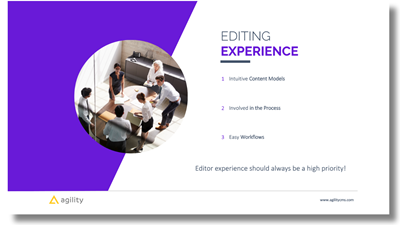Enhanced Editor Experiences in Headless CMS


In digital content creation, the user experience often takes center stage. However, amidst the spotlight on end-users, an equally vital player demands attention: the content editor. The effectiveness and efficiency of content editors are pivotal in ensuring that the content reaches the audience in a coherent and engaging manner. This is where content architecture steps in – an aspect that holds the potential to transform the editor's experience and, consequently, the overall content lifecycle.
Prioritizing Usability: Putting Editors First
When discussing usability, we often think of end-users navigating websites and apps. However, content editors are users too, and their experience must be a top priority. After all, the content creation process is intricate, involving numerous decisions, validations, and structures. For editors to be enabled and empowered to perform their tasks efficiently, the content architecture must be designed with their experience in mind.
Content models, which dictate how information is organized, need to be intuitive. Just like mapping a real-world concept, the structure should make sense to those using it. Even the arrangement of fields within a model can impact usability. The order of fields, the naming conventions chosen, and the selection of data types can greatly influence the ease with which editors interact with the system.
Incorporating User Input Early
A key strategy to ensure an intuitive content model is to involve content editors in the process from the outset. Their technical expertise and familiarity with the tasks are invaluable when shaping the architecture. The decisions about what content is crucial, how fields are named, and the order they appear in should be collaborative, reflecting the needs and understanding of those who will work with the system.
As the development progresses, continuous iteration becomes essential. Regular feedback from editors can identify pain points, improve usability, and result in a more user-friendly system. Incorporating their insights ensures that the content architecture is an evolving solution that remains effective as workflows and requirements change.
Crafting an Efficient Workflow
A smooth workflow is the backbone of content creation and publishing. However, it's not enough to simply impose a workflow onto the system. Instead, workflows should be tailored to the organization's unique needs. An eight-step process involving many team members might be ideal for some cases, while a streamlined approach might suit others better.
Workflow design necessitates a deep understanding of the organization's processes, including how content moves through various stages, who has approval rights, and where bottlenecks might occur. Ensuring that the workflow aligns with the reality of the organization's operations enhances efficiency and reduces frustration.
Holistic Considerations: Editors, Publishers, Business, and End Users

In the intricate ecosystem of content creation, several actors play crucial roles. Content editors are at the forefront, crafting and refining the content, while publishers ensure its accurate dissemination. The business perspective adds rules and guidelines that must be followed. And finally, the end-users, who ultimately consume the content, complete the cycle.
For a holistic content architecture that positively impacts all stakeholders, it's essential to harmonize these roles. Considering the editors' experiences as paramount from the outset acknowledges their pivotal role. The editors' ability to seamlessly create, validate, and publish content ripples through the workflow, business requirements, and, eventually the end-users experience.
Extending Content Architecture to Headless CMS: Enhancing Editor Experience
In content management, the concept of Content Architecture gains even more significance when applied to headless Content Management Systems (CMS). A headless CMS decouples content creation from its presentation, offering unparalleled flexibility and efficiency in delivering content across various platforms and devices. However, this flexibility can introduce complexity, making the role of content architecture even more crucial.
Empowering Editors in a Decoupled Environment
Headless CMS solutions separate the backend content repository from the frontend presentation layer, allowing editors to focus on crafting content without worrying about the intricate technical aspects of different platforms. Content architects are pivotal in designing headless CMS data models and content structures.
By tailoring the content models to match the editorial workflow and the organization's specific needs, editors can seamlessly create and manage content without grappling with technical intricacies. The arrangement of fields, the selection of content types, and even the integration of media assets become user-centric decisions, enhancing the editor experience.
Streamlining Content Distribution
One of the primary advantages of a headless CMS is the ability to distribute content across various channels, such as websites, mobile apps, IoT devices, and more. However, this can also introduce challenges in ensuring consistent content delivery and user experiences. Content architecture acts as a bridge between editors and the diverse array of platforms.
By structuring content models intelligently, content architects can enable editors to create content adaptable across different platforms. With the right content architecture, editors can input content once and trust that it will be seamlessly formatted and presented correctly across many endpoints.
Content Governance and Consistency
In a headless CMS, content must often adapt to different presentation styles and formats. However, this flexibility can sometimes lead to branding, voice, and messaging inconsistencies. Content architecture addresses this challenge by defining guidelines for content creation, ensuring a unified brand identity.
Content architects can enforce validation rules, format specifications, and even approval workflows within the content architecture. This ensures that editors create content that aligns with the organization's standards, regardless of the platform it's destined for.
Optimizing the Editorial Workflow
In a decoupled content management environment, the editorial workflow gains an added layer of complexity. The journey from content creation to approval and distribution involves intricate orchestration. Content architecture is crucial in designing workflows that seamlessly guide content through these stages.
By involving editors in the design of these workflows, content architects can create a fluid editorial experience. Editors can easily navigate the process, understand the status of their content, and collaborate effectively with other stakeholders.
Adapting to Future Demands
The dynamic nature of technology and content consumption requires organizations to stay agile and adaptive. A well-designed content architecture in a headless CMS isn't just a present-day solution; it's a future-proof investment.
By crafting content models that are modular and extensible, organizations can respond to changing content needs and emerging platforms. This adaptability ensures the content architecture enhances the editor experience as technologies evolve.
Content Architecture and Headless CMS
Headless CMS solutions are transforming how content is created, managed, and delivered in the world of content management. In this paradigm, content architecture emerges as the linchpin that bridges the gap between content creators and the diverse platforms where content is consumed.
Empowering editors, streamlining distribution, ensuring consistency, optimizing workflows, and preparing for the future are all made possible through thoughtful content architecture. As organizations embrace the potential of headless CMS, the role of content architects becomes even more vital in creating an ecosystem where content editors can produce exceptional content experiences across many touchpoints. By embracing content architecture principles within a headless CMS, organizations can unlock unparalleled agility, creativity, and impact in their content strategies.

About the Author
Harmonie is the Senior Marketing Manager at Agility CMS
